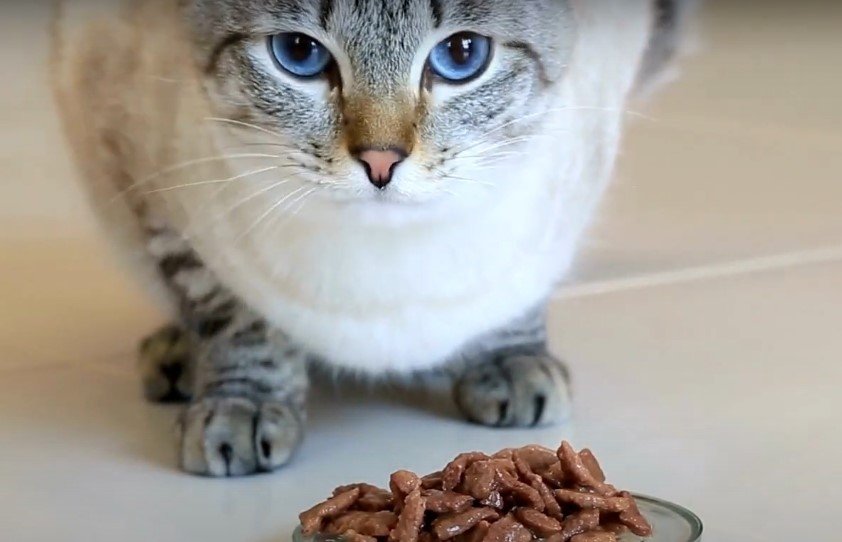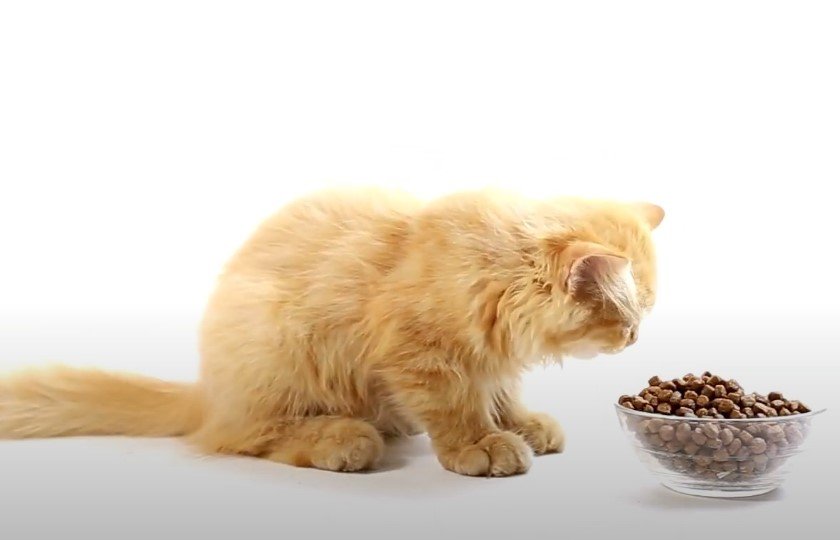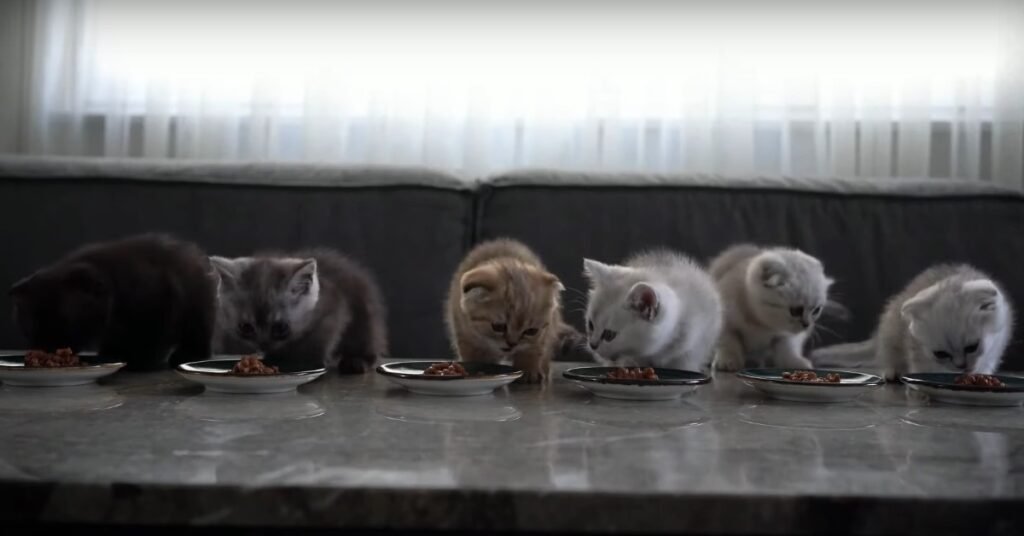
Generally, a cat is considered a kitten from birth until around 12 months (1 year) of age. After 12 months, cats are typically considered adults.
However, some larger breeds like Maine Coons may take longer to mature, up to 18-24 months fully. And some cats, especially smaller breeds, may reach physical maturity a bit earlier, around 9-10 months.
If you’ve ever wondered, “when to switch from kitten food to cat food” or “How long to feed kitten food?”—you’re not alone. Many cat owners face this problem. Switching too early or too late can affect your cat’s health.
Feeding kitten food for too long may lead to weight gain, while switching too soon can cause nutrient deficiencies. A sudden change can also upset your cat’s stomach.
Don’t worry—there’s a perfect time to switch! Here, I’ll explain when and how to transition from kitten to cat food properly.
Quick Table: Kitten Feeding Timeline
| Age | Milestone | Feeding Guidance |
| 0–4 weeks | Weaning begins | Introduce kitten food gradually (4 weeks) |
| 4–12 weeks | Rapid growth; all baby teeth emerge | Feed 3–4 times/day kitten food |
| ~30 weeks (~7 mo) | ~80% of adult body size | Begin planning switch |
| 9–12 months | Physical maturity/regression to slower growth | Ideal time to switch |
| 12–24 months | Large breeds finish growth | May continue kitten food until ~18–24 months |
When Should I Switch from Kitten to Cat Food?
The ideal time to switch from kitten to cat food is around 12 months of age, as most cats have completed their growth and no longer need the extra calories and nutrients found in kitten food.
However, some larger breeds, like Maine Coons, may need kitten food until 18 months to 2 years. In contrast, smaller breeds may reach physical maturity earlier, around 9 to 10 months, making them ready for the switch sooner.
Signs Your Kitten Is Ready for Adult Food
- Reached one year old (or longer for large breeds)
- Less playful and more relaxed
- Slower growth rate
- Eating less but maintaining a healthy weight
How to Switch from Kitten to Cat Food Smoothly
Introduce adult cat food to your kitten slowly. A quick change can upset their stomach.
If you change your cat’s food too quickly, it can cause digestive problems. The bacteria in its stomach don’t have enough time to adjust to the new food, which can cause diarrhea and vomiting.
Also, cats don’t like changes. They may refuse to eat if you give them new food too quickly.
To keep digestion smooth, switch their food over a 7 to 10-day period. Vets recommend this gradual transition for a healthy adjustment. Here’s how:
- Day 1-2: 75% kitten food + 25% adult cat food.
- Day 3-4: 50% kitten food + 50% adult cat food.
- Day 5-6: 25% kitten food + 75% adult cat food.
- Day 7-10: Serve 100% adult cat food.
“A 7-10 day gradual transition helps your cat’s gut bacteria adapt to the new diet, reducing the risk of diarrhea and food refusal.”
— Dr. Emily Parker, Companion Animal Nutritionist
Why is It Important to Switch From Kitten Food to Adult Cat Food?
Switching from kitten to adult cat food is important for your cat’s health. Kittens grow fast and need extra nutrients. So, kitten food has more calories, protein, and fat to help them develop strong bones and muscles.
In contrast, adult cats don’t need as much energy. Eating kitten food can lead to various health problems such as weight gain, digestive issues, nutrient imbalance, diabetes, kidney and liver strain, and dental problems.
Adult cat food contains essential nutrients that support overall health:
- Protein – Maintains muscle strength and energy.
- Healthy Fats – Provide energy and keep the coat shiny.
- Vitamins (A, B, D, E, K) – Support vision, immune health, and metabolism.
- Minerals (Calcium, Phosphorus, Magnesium) – Strengthens bones, teeth, and muscle function.
- Taurine – Essential for heart and eye health.
- Omega-3 and Omega-6 fatty acids help maintain healthy skin, promote shiny fur, and reduce inflammation.
- Fiber – Aids digestion and helps prevent hairballs.
- Water Content – Supports hydration, especially in wet food.
These nutrients help maintain heart, kidney, and joint health, boost the immune system, and improve digestion.
Adult cats have slower metabolisms, so they need food that is easier to digest.
AAFCO Minimum Nutrient Requirements for Kittens vs Adults
| Nutrient | Kitten Requirement | Adult Requirement |
| Protein | 30–36% (dry basis) | 26% |
| Fat | 9%+ | 9% |
| Taurine | 0.10% | 0.08% |
| Calcium | 1.0% | 0.6% |

What Should I Do If Switching From Kitten to Cat Food Causes Problems?
Switching from kitten to cat food can sometimes cause issues. Your cat may have an upset stomach, refuse to eat, or show signs of discomfort. If this happens, don’t worry. Here’s what you can do to help:
1. Slow Down the Transition – Gradual Change Prevents Digestive Issues
If your cat has digestive problems, return to the old food and switch more slowly. Try mixing 90% kitten food with 10% cat food and increasing the new food over 10-14 days.
2. Check for Food Sensitivities – Watch for Allergies and Reactions
Some cats react to new ingredients. Look for signs like:
- Vomiting or diarrhea
- Itchy skin or excessive scratching
- Refusing to eat
If these happen, try a different brand with fewer ingredients or ask your vet for advice.
3. Make the Food More Appealing – Encourage Your Cat to Eat
Cats can be picky eaters. If your cat won’t eat, try:
- Adding warm water to release flavors
- Mixing in a little wet food
- Offering smaller meals more often
4. Watch for Weight Changes – Ensure Proper Nutrition
If your cat loses weight or seems weak, switch back to kitten food for a while. Then, try a slower transition.
5. Consult a Vet – Get Professional Advice if Problems Persist
If problems continue for more than a week, visit the vet. They can check for allergies, food intolerances, or other health issues.
Troubleshooting Table
| Problem | Possible Cause | What to Do |
|---|---|---|
| Diarrhea | Too fast transition | Slow down; use 10–14 days |
| Refusal to eat | Dislike new flavor | Mix with warm water or wet food |
| Vomiting | Sensitivity | Try different brand/protein |
| Weight loss | Insufficient nutrients | Pause transition, consult vet |
FAQs:
1. When to switch from kitten to cat food?
The ideal time to switch from kitten to cat food is around 12 months of age, but it depends on their breed and growth rate. Some larger breeds, like Maine Coons, may take up to 18–24 months to mature. In contrast, smaller breeds may reach physical maturity earlier, around 9 to 10 months.
2. What happens if you switch adult cat food too early?
Switching too early can lead to nutrient deficiencies. Kitten food has extra protein, fat, and vitamins needed for growth. Without these, your kitten may become underweight or weak.
3. Can Young Cats Eat Senior Cat Food?
Young cats can eat senior cat food, but it’s not good for them. Kitten food has more protein, fat, and essential nutrients to support growth and energy needs. Senior cat food lacks these extra nutrients, which may lead to slow growth, weakness, or nutrient deficiencies in kittens. It’s best to feed kittens specially formulated kitten food until they are around 12 months old.
4. Do Cats Prefer Wet or Dry Food?
Cats have different tastes. Some prefer dry food because of the crunch. Others like wet food because it’s soft and has more moisture. Wet food can also be easier to eat for older cats or those with dental issues. You can also mix wet and dry food for a balanced diet.
5. Should I change my cat food quickly?
No, you shouldn’t change your cat’s food quickly. A quick change can upset your cat’s stomach. Always transition slowly over 7-10 days by mixing the new food with the old one.
6. Can I feed my senior cat adult cat food?
Not always. Senior cats (age 7+) may need special food with fewer calories and extra joint support. It’s best to transition them to senior cat food between the ages of 7 and 10 years. Check with your vet for the best option.
Final Thoughts
Every cat is different. Some kittens may need more time to adjust to adult food, especially if they have sensitive stomachs. Be patient and watch for any signs of discomfort.
As your cat matures, adult food provides the right balance of nutrients to keep them healthy. If you’re unsure about what to feed your cat, your vet can guide you on the best choices for their health.

